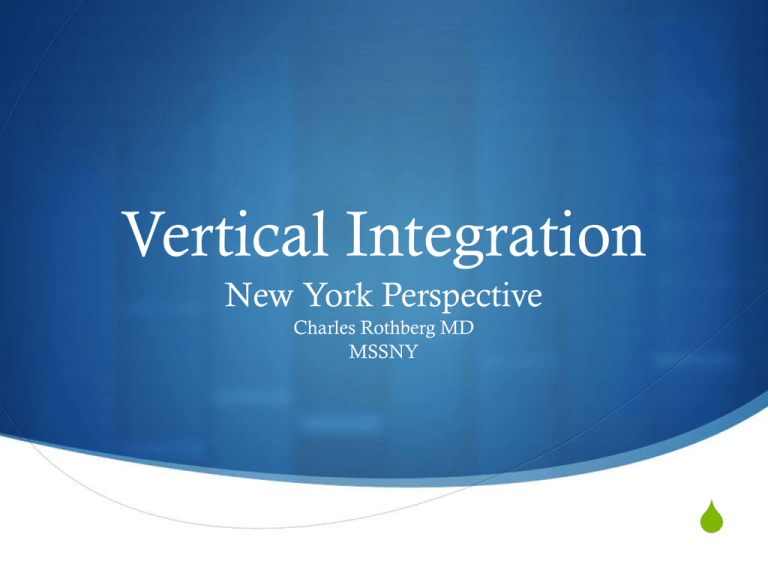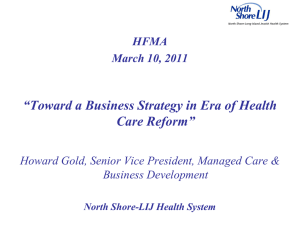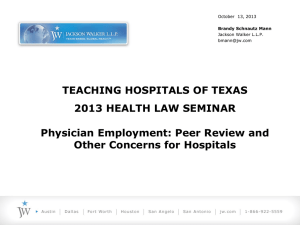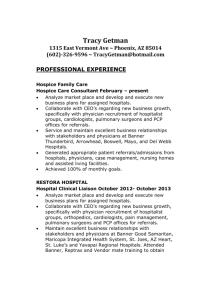Vertical Integration - Organization of State Medical Association
advertisement

Vertical Integration New York Perspective Charles Rothberg MD MSSNY S Out of Network, Out of Luck NYTimes 10.12.13 S Several hundred patients at the University of Pittsburgh Medical Center …no longer allowed to see their physician S All have insurance called Community Blue, which is offered by a rival hospital system. Most systems are in an ever-evolving state of integration S attempting to provide a full continuum of services S user-friendly, one-stop-shopping environment S eliminates costly intermediaries, S promotes wellness and S improves health outcomes. Clinical Integration S The integration of clinical information and healthcare delivery services from distinct entities. S Clinical integration refers to the coordination of care across a continuum of services, to improve the value of the care provided – thecamdengroup Clinical Integration S D-285.973 Clinical Integration S Our AMA will work with state medical societies to develop a white paper to educate physicians regarding clinical integration, including: (a) defining clinical integration; (b) researching Federal Trade Commission and Department of Justice advisories on clinical integration; (c) monitoring the progress of clinically integrated groups; (d) making policy and legislative recommendations; (e) developing a program to educate physicians about the benefits to physicians and patients, as well as the threats, concerning creating clinically integrated physician practices. (Res. 714, A-06) Long Island Business News, Sept 13, 2013 S ‘Hospital mergers lower costs through managerial efficiencies and improved care’ (or not!). When assets are specific, durable, and intensive, and transactions are frequent, vertical integration is likely to be warranted John Stuckey and David White (August 1993) Dana Blankenhorn, The Street (8/20/12) S The same hands collecting insurance dollars (and) delivering the care… (provides) a financial incentive to do health maintenance, just as owning your own car gives you an incentive to take it to the shop for regular oil changes. AHIP (May 17, 2013) S How consolidation and integration plays out will determine if (it is) providers or payers (that will) have more influence on competition , Michael Dowling President and Chief Executive Officer of North Shore-LIJ Health System S ‘I want to be completely vertically integrated. I want to have control of the dollars at true risk and to have control of the multiplicity of delivery points, which is ambulatory, longterm care, in-patient, home care, hospice, etc’. Horizontal Integration (Pan American Health Organization (2008) S “the coordination of activities across operating units that are at the same stage in the process of delivering services.” S grouping organizations that provide a similar level of care under one management umbrella. S It usually involves consolidating the organizations’ resources to increase efficiency and utilize economies of scale. Vertical Integration (Pan American Health Organization 2008) S “the coordination of services among operating units that are at different stages of the process of delivery patient services. S Unlike horizontal integration, which integrates organizations providing similar levels of care under one management umbrella, vertical integration involves grouping organizations that provide different levels of care under one management umbrella Horizontal Integration S Examples of horizontal integration include the following: S multihospital systems S mergers S strategic alliances with neighboring hospitals to form local networks Horizontal Integration S Some systems have demonstrated horizontal success by combining hospitals and then achieving higher reimbursement rates from payers: S Partners HealthCare S UPMC S Sutter Health Vertical integration S Efficiency goals S manage global capitation S form large patient and provider pools to diversify risk S reduce cost of payer contracting S Access goals S offer a seamless continuum of care S respond to state legislation S Quality goals S assume responsibility for health status of local populations Vertical integration S Can include acquisitions/alliances with the following: S Physicians (primary care providers, physician-hospital S S S S organizations, management service organizations, etc.) Health plans Academic medical centers Long-term care facilities Home care facilities Vertical integration S Kaiser Permanente is the most well-known example of a fully integrated delivery system. S Health Insurance Plan (HIP) in New York A substantial body of research demonstrates that many staff-model HMOs deliver high-quality and cost-effective care, yet • they have steadily lost market share, • replaced by more loosely managed networks of providers • Until now? Disadvantages of Vertical Consolidation S The bureaucratic end of a company becomes much more S S S S difficult. The upstream suppliers may not be able to match the demand of the downstream distribution centers. Adding additional services to a company may cause an overall quality loss. Costs might become higher due to the lack of competition in the market. Product variety is much reduced. The Provider Marketplace NS-LIJ S NS-LIJ S 16 hospitals, The Feinstein Institute (medical Research), rehab and snf ’s, home care network, hospice network, progressive care centers, Medical School S 46000 employees S Approved to issue insurance on the Obamacare Exchange S Employs Physicians The Provider Marketplace CHSLI S CHSLI S 6 hospitals, 3 nursing homes, hospice, palliative care and home services S 16,000 employees S centralizing its leadership and coordinating its clinical services to degrees it never has before. S grow the system’s Physician Hospital Organization, aco S the system has centralized its continuing-care operations – including hospice, palliative care and home services S developing new service lines in cardiology and cardiac surgery, orthopedic surgery, neurosurgery, cancer and bariatric surgery, similar to lines previously introduced by North Shore-LIJ S Recruits Voluntary Physicians The Provider Marketplace LIHN S LIHN S 10 Hospitals (including the CHSLI hospitals), clinically integrated. S Withstood 2002 attorney general challenge S Launched PHO to offer integrated products S Neglected (failed) to become an issuer of insurance The Provider Marketplace East End Alliance S East End Alliance S Eastern Long Island Hospital S Southhampton Hospital S Peconic Bay Medical Center S (Brookhaven Memorial Hospital Medical Center was urged but not required to join the alliance and left over governance issues) S Demanded by Berger Commission S To develop an integrated delivery system; S right-size and regionalize services; S secure emergency and acute care services at all three hospitals; S Develop affiliation agreements with Stony Brook University. Market Concentration S Hospital Market Share S over 75 percent of all United States metropolitan statistical areas have experienced enough hospital merger activity to be considered "highly consolidated.” (Health Affairs) S Payer Market Share S the largest insurer had 43 percent of the market for small group coverage in a typical state. In nine states, the largest carrier — a Blue Cross and Blue Shield company — has more than 50 percent. (The Government Accountability Office) Out of Network, Out of Luck NYTimes 10. 12. 13 S Historically, insurance companies have had more market power than hospital systems: S The Affordable Care Act, by offering incentives for coordinated care, has encouraged hospital mergers and the buying up of physician practices The Exchanges S Three New Issuers of Insurance S Oscar Health Insurance Corp S Health Republic S NS-LIJ Connect Care Out of Network, Out of Luck? (NYTimes H.B. 1621 S would require that all hospitals operating as part of an integrated delivery network contract with "any willing insurer" that desires to contract with it. S would prohibit such hospitals from requiring that the insurer agree to any contractual provisions that would restrict access to hospital facilities (i.e., steering provisions, anti-tiering provisions, etc.). S it would constitute a major shift in the contracting landscape for hospitals and insurers Concerns for Physicians S You may notice something missing from all this: doctors. S Vertical integration requires scale to work. Doctors don't work at scale, and they rightly fear becoming just cogs in a bigger machine - Dana Blankenhorn, The Street (8/20/12) Michael Dowling, President and Chief Executive Officer of North Shore-LIJ Health System S I look at the next decade as an exciting, opportunistic time. S The one thing we have to be careful of is that government doesn’t get into the business of micromanagement and believe that they have to regulate everything. S If everything becomes rules-based, you can destroy innovation and entrepreneurship. So we have to remain leery.• Out of Network, Out of Luck NYTimes 10.12.13 S ...'the worry is that integration will yield not better care but (just) higher profits achieved through monopolistic consolidations and self-serving business practices. The cost of care for an entire geographic region could increase without making patients better off.' Concerns for Physicians S John Stuckey and David White (August 1993) S Vertical integration is a risky strategy—complex, expensive, and hard to reverse.











